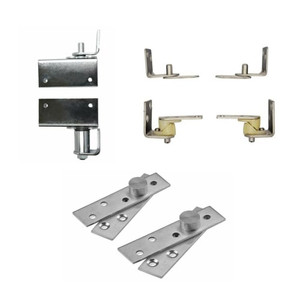
How Pivot Hinges Work | Types, Installation & Door Designs
Your Complete Guide to Pivot Hinges and How They Work
Looking to elevate your space with a stylish and functional swinging door? Pivot hinges might be the perfect solution. Whether you’re designing a modern entryway or installing saloon doors, understanding pivot hinge door detail, installation, and types is key to making the right choice.
Key Takeaways:
- Pivot hinges allow doors to rotate from a central axis, ideal for heavy or high-traffic doors.
- Options include gravity, spring, single-action, and double-action pivot hinges.
- Proper pivot hinge installation ensures durability and a seamless swing.
- Ideal for residential, commercial, and design-forward applications.
- Hidden and self-closing pivot hinge styles are available for added functionality.
What is a Pivot Hinge?
Pivot hinges are door hardware that allows your door to swing from a central axis. Contrary to traditional butt hinges that give a door around 90-degrees range of motion, pivot hinges enable doors to swing from a single pivot point. These pivot hinges can also be hidden, recessed, or installed on the top and bottom of your door.
While a traditional door only opens in one direction, a door hung on pivot hinges utilizes a swinging motion, and double-action hinges can open and close in either direction. First, decide how you need the door to work to determine the best pivot hinge for your application.
How Do Pivot Hinges Work?
A pivot is a central point on which something turns. Pivot hinges allow a door to swivel from the same axis at both the top and bottom of the door.
Traditional butt hinges connect to the door and the frame by a pin that locks the two sides together. Pivot hinges move more like a joint. One side of the hinge locks into the other one and can rotate freely around it.
What are the Benefits of Pivot Hinges?
Pivot hinges are ideal for:
- Areas of high traffic
- Heavier, wider doors
Heavy doors create high amounts of stress on a door frame and can cause sagging. Pivot hinges combat that problem because, on large doors, they attach to the floor and the top of the unit instead of the door frame.
Imagine a busy restaurant. Servers often come and go from the kitchen with their arms full of heavy trays. Pivot hinges create a door set-up that is easy to push open even when your hands are full, and will automatically return to center.
Besides high traffic areas and heavy doors, pivot hinges can be used on smaller, stylized doors such as saloon doors and louvered doors. Saloon doors can vary from modern to farmhouse style doors, making pivot doors an option for nearly any home style and budget. Adding a grand door design allows the door to go from floor to ceiling. Pivot hinges are perfect for this door design. The hidden hinge will allow the door design to speak for itself. Because the hinges are at the top and bottom of the door, they can be easily hidden and increase the aesthetic appeal of the door. Hidden pivot hinges offer the best full-height option, but do not automatically return the doors to center.
Pivot Hinge Types Explained
Gravity Pivot Hinges
These use the door’s weight to return it to the closed position. A gravity pivot hinge is low maintenance and ideal for high-use areas. Many include a hold-open feature at 90 degrees.
Spring Pivot Hinges
These use an internal spring to control the door’s return speed and force. Some models include adjustable tension and hold-open functionality.
Hidden Pivot Hinges
Recessed into the top and bottom of the door and frame, hidden pivot hinges maintain a minimalist aesthetic while providing smooth operation.
Single vs. Double-Action Hinges
- Single-action pivot hinges swing in one direction only, ideal for walls or narrow passageways.
- Double-action pivot hinges swing both directions and return to center—perfect for saloon doors or commercial kitchens.
Pivot Hinge Door Detail: Center-Hung vs. Offset
Center-Hung Pivot Hinges
These are mounted directly in the center of the door’s top and bottom, allowing it to pivot evenly on both sides. This creates an elegant, symmetrical opening and is commonly used in upscale residential or office doors.
Offset Pivot Hinges
These are installed closer to the edge of the door, offering better clearance for baseboards or trim. An offset pivot hinge provides more control over how much of the door enters a space when opened.
Installing Pivot Hinges
Installing pivot hinges involves careful measurement and preparation. Here’s a general process:
- Decide between center-hung or offset mounting.
- Mark and drill the top and bottom pivot points on the door and the frame or floor.
- Recess the hinge components if necessary.
- Secure each hinge in place with screws and ensure vertical alignment.
- Test door swing and make any necessary adjustments.
You can reference our installation videos or contact us for guidance on installing pivot hinges for your door style.
Where Can You Buy Pivot Hinges?
You've learned all the basics of pivot hinges. Now that you have this new knowledge, you're ready to pick out the right door and hardware. You might be wondering, Where do I start?
With the help of a professional, you can choose fully customized pivot doors with perfectly complementary pivot hinges that elevate and increase the functionality of your space.
Contact us with any of your pivot hinge or swinging door needs!
